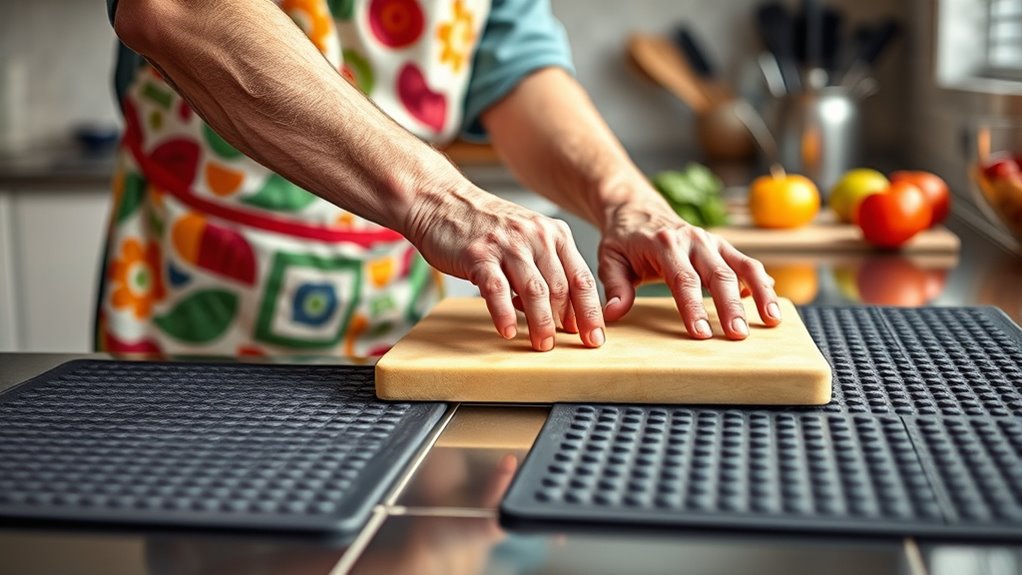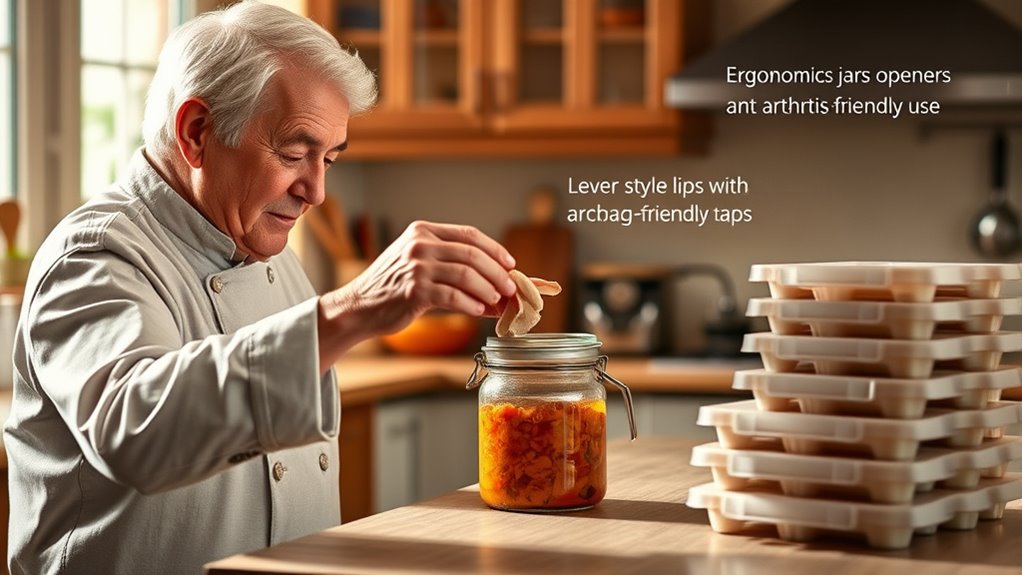To make your kitchen arthritis-friendly, use ergonomic tools like lightweight utensils and easy-grip knives to reduce joint strain. Incorporate non-slip mats and stability grips to prevent accidents. Opt for adaptive techniques such as rocking knives and adjustable cutting boards. Easy-open containers and smart storage can save effort and bending. Adding low-impact gadgets and adjustable work surfaces keeps tasks comfortable, while hand exercises maintain strength. Keep exploring these tips to make your kitchen safer and easier to navigate.
Key Takeaways
- Use ergonomic kitchen tools like lightweight utensils and easy-grip knives to reduce joint strain during cooking.
- Incorporate safety features such as non-slip mats, organized storage, and easy-open containers to prevent accidents and minimize effort.
- Adjust work surface height and keep frequently used items at waist level to decrease bending and reaching.
- Utilize time-saving gadgets like food processors and automatic jar openers to lessen physical exertion.
- Practice hand and joint exercises to maintain flexibility, strength, and reduce stiffness for safer kitchen tasks.
Ergonomic Kitchen Tools for Comfortable Cooking

Using ergonomic kitchen tools can make a significant difference in reducing joint strain and making cooking more comfortable. When you choose tools designed with ergonomic features, you support better kitchen safety by minimizing the risk of slips or accidents caused by discomfort or fatigue. These tools, like easy-grip knives or lightweight utensils, help you maintain control and prevent unnecessary exertion. Incorporating ergonomic tools into your meal planning ensures you can prepare meals more efficiently without putting extra stress on your joints. This thoughtful approach not only makes cooking safer but also allows you to enjoy the process more. Ultimately, ergonomic kitchen tools empower you to stay independent and active in the kitchen, even as arthritis challenges increase. Fostering independence in the kitchen is crucial for maintaining a high quality of life and confidence while cooking.
Non-Slip Mats and Grips to Prevent Accidents

Non-slip mats and grips are essential for creating a safer kitchen environment, especially when handling slippery or wet surfaces. They help prevent accidents by providing stability on countertops, floors, and cutting boards, reducing the risk of falls and injuries. Using non-slip mats also promotes better cooking safety, as you can focus on your tasks without worrying about slipping. Additionally, these mats and grips contribute to kitchen hygiene by keeping surfaces steady, which minimizes accidental spills and messes. They’re easy to clean, ensuring your workspace remains sanitary. Incorporating non-slip accessories is a simple way to protect yourself and maintain a safe, clean cooking environment. With these tools, you can enjoy cooking more comfortably while reducing hazards caused by slippery surfaces. Implementing appropriate safety measures such as non-slip mats can also improve overall kitchen efficiency and confidence during meal prep.
Adaptive Cutting Techniques to Reduce Strain

To minimize hand and wrist strain while preparing meals, adopting adaptive cutting techniques can make a significant difference. Try adaptive slicing, which involves using tools like a rocking knife or adjustable blade to reduce effort and improve control. When doing joint-friendly chopping, use a sturdy, stable cutting board with non-slip grips to secure your workspace. Keep your fingers curled under your hand to protect joints and use your whole arm rather than just your hand for slicing. Apply gentle, steady pressure instead of forceful cuts. Using ergonomic knives with comfortable handles also helps lessen joint strain. These techniques allow you to cut more efficiently while minimizing discomfort, making meal prep safer and less tiring for your joints.
Easy-Open Containers and Packaging Solutions

Finding easy-open containers and packaging can considerably reduce hand and wrist strain during meal prep. Look for packaging with pull tabs, flip lids, or push-button openers, which require less grip strength. Recyclable packaging options are also available, making it easier to dispose of containers responsibly. When choosing products, check for tamper evident seals; these provide safety without needing extra effort to open, giving peace of mind. Many brands now design packaging with arthritis-friendly features, such as larger tabs or ergonomic grips, simplifying the process. By selecting these solutions, you minimize discomfort and save energy, making kitchen tasks more manageable. This approach supports independence and helps you enjoy cooking without unnecessary pain or frustration.
Smart Storage Ideas for Accessibility

Implementing smart storage solutions can greatly improve accessibility in your kitchen, making everyday tasks easier and less painful. Focus on pantry organization by grouping similar items together and using clear containers for visibility. This reduces the need to search and minimizes strain. Labeling systems are essential; use large, easy-to-read labels to identify contents quickly. Consider installing pull-out shelves or lazy Susans to access items without reaching or bending. Keep frequently used ingredients at waist level to avoid unnecessary stretching or bending. Adjustable racks and hooks can optimize space and keep utensils within easy reach. These simple changes help you save effort, reduce discomfort, and maintain an organized, arthritis-friendly kitchen environment. Maximize space and organization to further enhance ease of use and reduce clutter.
Low-Impact Cooking Methods for Joint Relief

Using gentle stirring techniques can reduce strain on your joints while cooking. Non-stick cookware also helps by minimizing the force needed to flip or stir ingredients. These low-impact methods make meal preparation easier and more comfortable for your joints.
Gentle Stirring Techniques
When stirring ingredients in your kitchen, applying gentle, controlled movements can make a significant difference if you have joint pain. Using proper stirring techniques reduces strain on your joints and makes cooking more comfortable. Focus on efficient spoon handling to minimize effort. Here are four tips:
- Use a lightweight, ergonomic spoon to ease grip and reduce fatigue.
- Keep your wrist steady, using your arm to move the spoon, not just your hand.
- Stir with smooth, circular motions rather than vigorous or rapid movements.
- Rest your hand or wrist periodically to prevent overexertion during prolonged stirring.
These simple adjustments help protect your joints while maintaining effective stirring, making your cooking experience more arthritis-friendly.
Non-stick Cookware Benefits
Non-stick cookware offers a simple yet effective way to reduce joint strain during cooking. With non-stick surfaces, you can use less oil and avoid vigorous scraping, making meal prep easier on your joints. While cast iron and stainless steel pans are durable, they often require more effort to clean and may cause additional strain. Switching to non-stick options minimizes the need for scrubbing and reduces wrist and hand fatigue. You can cook delicate foods like eggs or pancakes without sticking, saving you from frustrating and forceful motions. This gentle approach helps protect your joints while still allowing you to prepare flavorful meals. Incorporating non-stick cookware into your kitchen promotes low-impact cooking, making mealtime less painful and more enjoyable. Additionally, choosing modern, water-efficient toilets can help conserve water and reduce utility costs in your household.
Adjustable Height Work Surfaces for Comfort

Adjustable height work surfaces let you customize your workspace to fit your needs. They help reduce bending and awkward positions, easing joint strain. With the right settings, cooking becomes more comfortable and less tiring. Incorporating user-friendly setup features can further simplify adjustments and enhance safety during use.
Customizable Height Settings
Having the right countertop height can make meal prep much easier and less painful for arthritis sufferers. With customizable height settings, you can create ergonomic workstations tailored to your needs. This flexibility reduces strain and makes daily tasks more comfortable. Here are some benefits:
- Easily adjust countertops to suit different tasks or users.
- Minimize bending or reaching, reducing joint stress.
- Improve posture and reduce fatigue during kitchen work.
- Increase safety by preventing slips or overexertion.
- Analytical cookies can help monitor how different height settings impact your comfort and workflow.
Reduces Bending Strain
When countertops can be adjusted to the perfect height, you naturally avoid the need to bend over excessively, which is often painful for arthritis sufferers. This simple change markedly reduces bending strain during meal prep and cleanup. With an ergonomic setup, you can focus on joint-friendly recipes and arthritis-friendly meal planning without added discomfort. Adjustable work surfaces make it easier to reach ingredients and tools, minimizing the stress on your hips, knees, and back. By maintaining a neutral, comfortable posture, you conserve energy and reduce joint pain. This setup not only improves your cooking experience but also encourages healthier, arthritis-friendly meals. Over time, you’ll find that reducing bending strain helps you stay active and independent in the kitchen. Incorporating self-watering plant pots into your home can also reduce the need for frequent watering, further minimizing repetitive tasks and joint strain.
Enhances Cooking Comfort
By setting your work surfaces to the right height, you can enjoy a more comfortable and efficient cooking experience. Adjustable height work surfaces help reduce strain on your joints, making food preparation easier. This setup also improves your food presentation, as you can work at a level that promotes better control and detail. Plus, it simplifies ingredient selection and handling, minimizing unnecessary reaching or bending. Consider these tips: 1. Choose work surfaces that can be easily adjusted to your preferred height. 2. Use ergonomic tools that complement your work surface. 3. Keep frequently used ingredients at waist level for quick access. 4. Adjust surface height based on task, whether chopping or plating, for maximum comfort and precision. Incorporating ergonomic design principles into your kitchen setup can further enhance comfort and reduce fatigue during prolonged cooking sessions.
Time-Saving Gadgets to Minimize Effort

For anyone managing arthritis, using time-saving gadgets can make a significant difference in the kitchen. These tools streamline tasks like meal planning and grocery shopping, reducing unnecessary effort. For example, digital meal planners help you organize recipes and shopping lists quickly, saving time and minimizing stress. Automatic jar openers and ergonomic can openers take the strain out of opening bottles and containers, making prep work easier. Hands-free grocery baggers or lightweight carts simplify shopping trips, cutting down on physical exertion. Food processors and choppers speed up chopping, slicing, and blending, saving you from repetitive motions. With these gadgets, you spend less time on tedious tasks and more time enjoying your meals, all while protecting your joints and reducing pain.
Tips for Maintaining Hand Strength and Flexibility

Maintaining hand strength and flexibility is essential for managing arthritis symptoms and preserving daily function. Regular hand exercises and joint stretches help keep your hands nimble and reduce stiffness. Incorporate these simple tips into your routine:
Regular hand exercises and stretches help manage arthritis pain and maintain mobility.
- Perform gentle hand squeezes using a soft stress ball or putty to strengthen grip.
- Do finger lifts by placing your hand flat and lifting each finger individually.
- Stretch your joints by gently bending and straightening your fingers several times daily.
- Rotate your wrists slowly in circles to improve flexibility and reduce joint stiffness.
- Engaging in aquatic exercises can provide low-impact resistance training that benefits joint mobility. Aquatic exercise
Consistent practice helps maintain mobility, eases pain, and prevents further joint deterioration. Remember, gentle movements are key—don’t push beyond your comfort zone.
Frequently Asked Questions
How Do Ergonomic Tools Reduce Joint Strain During Cooking?
Ergonomic tools reduce joint strain during cooking by promoting joint protection with their user-friendly design. They are crafted to fit comfortably in your hand, requiring less grip force and reducing pressure on your joints. By using ergonomic design, you minimize awkward movements and repetitive stress, making cooking easier and safer. This helps prevent pain and fatigue, allowing you to enjoy your culinary activities with less discomfort and greater efficiency.
What Are the Best Non-Slip Mats for Safety in the Kitchen?
Imagine stepping onto a soft, textured surface that keeps you steady while you cook—these non-slip mats are your best safety allies. Look for ones with vibrant kitchen decor designs that blend seamlessly into your space and provide excellent grip. They’re perfect for handling slippery spills and keeping your focus on cooking tips that make your kitchen safer. With the right mats, you’ll enjoy confident, stress-free meal prep every time.
Which Adaptive Cutting Techniques Are Easiest for Beginners?
For beginners, the easiest adaptive cutting technique involves a secure knife grip, like the pinch grip, to maintain control. Keep your cutting board stable by using non-slip mats underneath to prevent slipping. Focus on cutting slowly and evenly, applying steady pressure. Using a damp towel under your board can also enhance stability. With practice, these simple adjustments make cutting safer and more manageable, especially if you have arthritis or limited hand strength.
How Can Smart Storage Improve Kitchen Accessibility?
Smart storage considerably improves kitchen accessibility by enhancing kitchen organization and making items easier to find and reach. You can use labeled, clear containers and pull-out shelves to keep everything visible and accessible, reducing the need for bending or stretching. Installing storage solutions like wall-mounted racks or lazy Susans maximizes space and keeps frequently used items within easy reach, making your kitchen safer and more user-friendly for everyone.
What Are Simple Exercises to Maintain Hand Flexibility?
To maintain hand flexibility, you should do simple hand stretching exercises daily. Gently stretch your fingers outward and hold for a few seconds, then relax. Try finger strengthening exercises like squeezing a soft ball or using therapy putty to improve grip and dexterity. These activities promote better hand mobility, reduce stiffness, and help you stay comfortable while cooking or performing daily tasks. Consistency is key for lasting benefits.
Conclusion
By embracing these arthritis-friendly kitchen tricks, you’re turning your space into a sanctuary of ease and independence—much like a seasoned captain steering familiar waters. Remember, small adjustments can lead to big comfort, helping you cook with confidence and joy. Just as a steady hand guides a delicate brushstroke, these tools and techniques empower you to create nourishing meals without the strain, keeping your passion for cooking alive and well.









